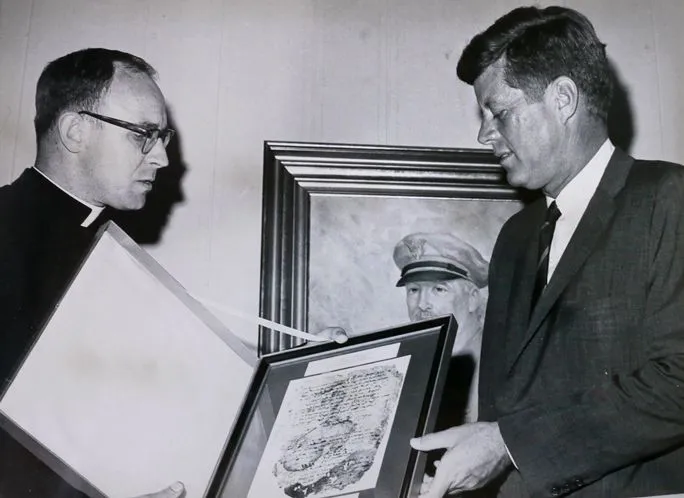On November 22, 1963, President John F. Kennedy was shot and killed as his motorcade drove through Dallas, Texas.
President Kennedy spent the week before his death in Florida.
After a short stay at his family’s winter residence in Palm Beach, Kennedy toured the NASA facilities at Cape Canaveral before visiting Tampa and Miami.
On his last day in Florida, President Kennedy met with Florida historian and Catholic priest Michael Gannon. As the first and only Catholic American president, Kennedy was particularly interested in Gannon’s area of expertise, Catholicism in Spanish Colonial Florida.
When Gannon spoke with President Kennedy on November 18, 1963, he was a priest in St. Augustine, preparing to celebrate the 400th anniversary of the founding of the city.
“At the old mission where the first Parrish Mass was celebrated on September 8, 1565, it was decided to build a cross,” Gannon said. The cross was to be built on the site where Don Pedro Menéndez de Avilés first landed to settle St. Augustine, and where Father Francisco López observed the city’s first Catholic Mass.
“Ultimately it was constructed of stainless steel and rose to a height of 208 feet. I think it’s very impressive. It can be seen 14 miles out to sea. It has become a symbol of the first mission to the North American Natives and the first Parrish established by Europeans in this country,” said Gannon.
Also part of St. Augustine’s 400th anniversary celebration in 1965 was the expansion and redecorating of the cathedral church, the construction of a contemporary church called The Prince of Peace, and a bridge linking the new church with the historic mission grounds.
President Kennedy’s Catholicism had been an issue during his election campaign, and he gave a national speech on the topic to reassure voters.
Spain controlled Florida for nearly three centuries. Gannon told Kennedy about the extensive and complex history of Catholicism in Florida.
“Everywhere Spain moved politically and economically and militarily, the church moved, too,” said Gannon.
“The church was always a partner of Spanish expansion. The church was on the forefront. If you want to select any part of the Spanish cultural presence in Florida and the rest of North America, you would have to say that the church was in advance of all other institutions.”
The Florida Chamber of Commerce arranged the meeting between Gannon and Kennedy as St. Augustine was preparing for its 400th anniversary celebration.
“It was hoped by the Chamber of Commerce and by the city fathers in St. Augustine, that the president would agree to come down earlier rather than later,” said Gannon.
“It was uncertain if he would be elected to a second term, so they wanted him to come while president and to build up interest in the city that would help generate tourist traffic for the 400th year.”
It was arranged for Gannon to meet the president at the MacDill Air Force Base Officer’s Club.
“I brought him a photographic copy of the oldest written record of American origin, which was a Parrish Register of Matrimonial Sacrament, a marriage between two Spaniards, a man and a woman, here in the city of St. Augustine, dated 1594,” said Gannon.
“He seemed to be very grateful to receive the gift of the photographic copy that was beautifully framed.”
President Kennedy was intrigued by Gannon’s stories about the oldest continuously occupied European city in what would become the United States.
“As he left he said ‘I’ll keep in touch.’” Gannon said, pausing to recall the moment. “But four days later he was dead.”
Michael Gannon retired from the priesthood in 1976, but continued his illustrious career as one of Florida’s most respected historians and educators, teaching at the University of Florida.
Gannon’s best known non-fiction book is “The Cross in the Sand,” written in 1965 and republished in 1999. He was editor of and contributor to the book “The History of Florida,” originally published in 1996 and revised in 2013. Gannon’s creative work includes the 1994 novel “Secret Missions” set in Florida during World War II, and the play “My Friend Zelma: Marjorie Kinnan Rawlings on Trial.”
Gannon died in Gainesville in April 2017, at the age of 89.
